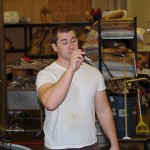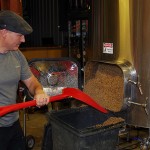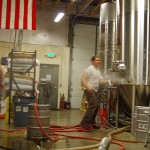
The image of the craft beer brewer is now familiar to most beer drinkers: beard, rubber galoshes, a baseball cap, consuming endless beers. … It’s not just one long keg party in waterproof shoes at Top Rung Brewing Company in Lacey, Washington. Founders Casey Sobol and Jason Stoltz are all business. Sure, they joke and spray water at their sales rep Mike Besser at every opportunity, but the two Thurston County firefighters turned brewers bring their initial career training to the brewery — physical fitness, mechanical aptitude, dedication and teamwork. These two would be the last two standing on “Brewers Survivor.” And, they make mighty fine craft beer. I know. I recently had a 360-view during the brewing of their latest batch of Three Sixty Red. Grab a pint or two of this delicious, medium bodied, light caramel beauty and enjoy this behind the scenes tale.
THE MORNING MASH
Interstate 5 construction in multiple locations and the merging traffic surrounding Joint Base Lewis-McChord was the first recipe of the November day — a recipe for tardiness. “Sorry, sorry, sorry” I shouted over the hum of the mash tun. Head Brewer Stoltz and Operation Manager Sobol laughed, suspending their tasks for handshakes and the day’s agenda. The brewing recipe tells us that we’ll need to use four types of malt, one hop, and both gypsum and acid malt to aid in the stabilization of the water. The malt bill calls for ample Red X malt, with Caramel, Chocolate and Base Pale malts. Willamette is the hop, two fresh bags full for slightly spicy and floral tones. The yeast is a flocculent English variety called Safale — Stoltz’s favorite. Flocculent yeast varieties are easier to reuse making them highly desirable among brewers.
We began by heating the water in the mash tun. The guys don’t mess around; their timing was impeccable all day. We also prepped and sanitized the fermenter. Cleaning and sanitizing is by far the most important part of the brewing process. They both stressed this throughout the morning.
The water took an hour to reach the right temperature. So off we went for coffee and breakfast burritos.
This needs to be on record: I’d set my house on fire to hang out with these firefighters/brewers/gentlemen. Check that, I’d rather be the tail-wagging Dalmatian wedged between them racing around town saving people — including the time they raced out of their Lacey brewery across the street to rescue a car crash victim. They’re genuine nice guys. You need to meet these two fine gents. Make it a part of your day, your week, your life. Sobol and Stoltz are the next Jimmy Fallon and Justin Timberlake, albeit with less song and dance numbers.
The plan was consistent and controlled growth from the day Top Rung opened the doors in April 2014. They began brewing with one 20-barrel fermentation vessel, one 10-bbl FV, one 20-bbl Brite tank and two 10-bbl Brites. Since then, they’ve added another 20-bbl FV with two more arriving this year, one next week.
“The new 20-barrel fermenters will significantly increase our total barrel capacity,” says Sobol. “We are currently projecting to do about 1,000 barrels in 2016. This is following the continued growth that we see and the hard work that Mike is doing out in the field. Some other big parts of this growth in 2016 include the addition of the new six-head Meheen bottler that we will be using in collaboration with Wingman Brewers and adding a new distributor in the areas beyond Mike’s reach.”
In addition to the future plans, we discussed family, television series and their firefighting careers. Jo’s Coffee Bar makes a mean breakfast burrito.
Back at the brewery, Sobol and I ripped open 12-and-a-half bags of malt. This is where the heavy lifting begins. Sobol put me to work lifting and dumping the 55 lb. bags of malt into the grist case. The malts are crushed together to break up the grain kernels in order to extract fermentable sugars, then up the tubing and into the mash/lauter tun.
Stoltz kept a steady stir on the mash conversation — the process extracted the sugars from the grain and along with water helped to create the wort. Stirring inside assures an even mash so as to evenly extract the sugars leaving little waste.
Vorlauf is the process of clarifying the wort being drawn out of the mash tun. They drew small portions of the wort slowly into a container and then pouring softly back onto the top of the mash; taking care to disturb the grain bed as little as possible. The primary objective was to establish the grain bed as a filter for the wort being drawn off. The grain husks will then act as a sand-style filter to further enhance clarity. Stoltz checked the clarity during the Vorlauf boil off more than I checked the shape of my inappropriate footwear — which means a great deal. This is true craft brewing. Only one button — the “Christmas Tree” switch — was pushed during the entire 11-hour day.
Besser came through the back door with an eight case order. Between the three I counted 14 one-liners dropped. The Three Sixty Red will take 21 days to maturity, nine in the fermenter, filling 35 kegs with five barrels to be bottled.
During the recirculation, the Three Sixty Red clocked in with an original gravity of 1080 on the hydrometer, which is barleywine strength. This is the specific gravity of the unfermented wort. The primary contribution to specific gravity is sugar, some of which is fermented into alcohol, and some of which remains in the finished beer to give sweetness and body. From experience, Stoltz believed the OG was actually 1095.
SPARGING LARGE
After 25 minutes, the mash ran clear, meaning no large pieces of grain material, and the sparging began.
During sparging, grains were cold water rinsed of their sugars before the short journey to the boil kettle to start the process of lautering, which is basically the collecting of the extracted sugars. The temperature of the sparge water is important. The water should be no more than 170°F, as husk tannins become more soluble above this temperature, depending on wort pH. This could lead to astringency in the beer. Lacey municipal water has close to ideal minerals in its water. They only needed four pounds of acid malt and a little gypsum to keep the optimal pH level.
The wort was drained slowly to obtain the best extraction. Their lauter grant, a vessel that gently collects the wort on its way from the mash/lauter tun to the boil kettle, was the same grant they used when they homebrewed. The career firefighters — 21 years for Sobol and eight for Stoltz — dialed in their recipes in garages between shifts at the McLane/Black Lake Fire Department. It became real when the duo’s Hosechaser Blonde grabbed the Dick’s Brewing “Beer for a Cure” homebrewing contest top prize in 2012 — and they began to shadow Dick’s brewer Parker Penley.
Stoltz took wort samples from the grant with which to conveniently measure the pH of the runoff and avoid over-sparging. The OG decreased to 1067 after two-thirds of the wort traveled through the grant. Sparge time varies depending on the amount of grain and the lautering system; we spent the first 30 minutes manning five tasks, then an hour and a half of down time. That’s when Stoltz cranked on the tunes — Fleet Foxes if I remember correctly.
Time to clean again.
I suggested they run a Crossfit gym inside their brewing room. I twisted, ducked and jumped over hoses and pumps all day. It’s good to be a brewery hose manufacturer.
Over sandwiches, we played guess the hop with blind samples. I know my Simcoe.
Foals’ song “What Went Down” blasted as we pulled nails and tasted red wine and bourbon barrels full of Pyrolysis Imperial Stout, which have since been release to applause.
THE FINAL PUSH
The wort hit full boil in the kettle when I added 64 ounces of Willamette hop and another 96 ounces of the same hop with 10 minutes left in the whirlpool.
I practiced clapping hoses with one hand on the fermenter. Besser barged through the back door with more orders. He figured I was great at one-hand hose couplings.
With the boil officially complete, we “knocked off,” meaning we moved the wort from the kettle to its new home in the fermenter where it will meet the yeast and eventually (three weeks later) become beer. It’s important though that we lowered the temperature of the wort down to 70° before the transfer so as not to kill the yeast. A wort chiller did the trick in a matter of minutes.
Stoltz climbed a latter (for the 10,000th time in his life) and dumped the Safale dry yeast into the top of the fermenter. Yeast converts the sugary wort into beer by producing alcohol, a wide range of flavors and carbon dioxide (used later in the process to give the beer its sparkle).
Knocking off and the yeast dump were the final parts of the actual brewing process but we had plenty of cleaning ahead. We were done moving the beer.
According to Stoltz, it was one of the faster brew days, even with me in the room.
The Three Sixty Red is currently on tap in Top Rung’s taproom. Thankfully, it’s delicious.
TOP RUNG BREWING COMPANY, 4-9 p.m. Thursday, 2-9 p.m. Friday, 2-9 p.m. Saturday, open Sunday during Seahawk games, 8343 Hogum Bay Lane NE, Lacey, 360.915.8766



















